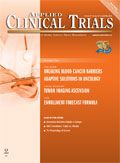FDA, Sponsors Look to Expand Patient Input to Clinical Trials
Applied Clinical Trials
Patient focused drug development is playing a larger role in study design and outcome measurement.
Patient focused drug development (PFDD) is moving into the mainstream, promising to alter the conduct of clinical trials and FDA regulatory policies. PFDD appears increasingly useful and accepted in designing studies and in assessing outcomes and treatment benefits most important to patients with a certain condition. Building on the experience gained from a series of FDA meetings to solicit patient perspectives for treating chronic conditions, sponsors are querying patient groups to help define the key goals of clinical studies and to avoid research programs that yield less useful results. FDA is bringing in patients to consult with review divisions and to join FDA-sponsor meetings to help shape research studies and product labeling.
To further this trend, FDA is expanding its patient representative program beyond participation in advisory committee meetings. The agency has identified some 200 patient representatives based on their experience, FDA training, and clearance on conflicts of interest. Last year, members of this cadre were involved in 10 consultations with FDA review divisions and in additional meetings with sponsors, explained Richard Klein, head of FDA's patient liaison program in the Office of Health and Constituent Affairs. Qualified patient representatives not only have experience with a disease or condition, but are active in patient advocacy organizations, knowledgeable about treatment options, and able to grasp basic scientific principles, Klein pointed out at the recent conference on PFDD sponsored by the University of Maryland Center of Excellence in Regulatory Science & Innovation.
One FDA initiative is to develop a "roadmap" to patient-focused outcome measurement in clinical trials, reported Ashley Slagle of the Office of New Drug (OND) Study Endpoints and Labeling Development staff in the Center for Drug Evaluation and Research (CDER). The roadmap aims to establish an orderly pathway for selecting or developing instruments to accurately measure treatment benefit, she explained. Key criteria are the natural history of the disease or condition, the affected patient population, treatment alternatives, and current care standards.

Unlock Commercial Growth through Data-Driven Patient and HCP Insights
May 2nd 2025Leveraging data-driven patient and healthcare provider (HCP) insights, including social drivers of health (SDOH), is essential for life sciences companies to continuously improve patient engagement and commercial success. Mark Rodgers, AVP of Commercial Analytics at Inovalon, discusses how identifying treatment milestones, assessing HCP performance, and segmenting patient populations using SDOH data can drive targeted strategies that improve healthcare outcomes and market access
Improving Relationships and Diversifying the Site Selection Process
April 17th 2025In this episode of the Applied Clinical Trials Podcast, Liz Beatty, co-founder and chief strategy officer, Inato, discusses a number of topics around site engagement including community-based sites, the role of technology in improving site/sponsor relationships, how increased operational costs are impacting the industry, and more.
FDA Approves Nipocalimab for the Treatment of Generalized Myasthenia Gravis
April 30th 2025Approval is based on results from the pivotal Vivacity-MG3 trial in which IMAAVY (nipocalimab-aahu) demonstrated superior disease control throughout 24 weeks when compared to placebo plus standard of care.